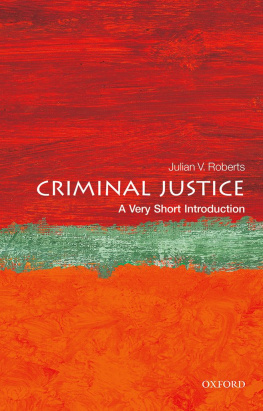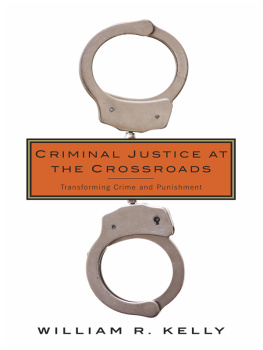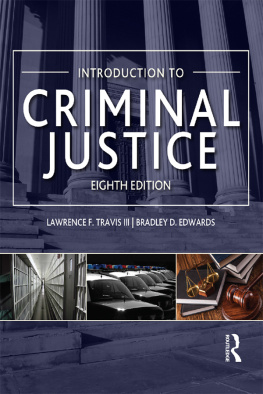Since the first edition of Crime and Justice since 1750 was published in 2005 I have drawn on it many times as a teaching tool for crime history and British social history-focused modules. For students, it engages with the key historiography and core paradigms in the field in a clear and accessible form. For postgraduates and academics, it provides an excellent overview of the field. This very welcome second edition comes with the inclusion of a modern parallels section in each chapter, bringing the field topically up-to-date and ensuring the appeal of the book to a broad audience.
Heather Shore, Reader in History,
Leeds Beckett University, UK
This is a very timely book. It breaks the boundaries between criminology, crime history and social history and shows just how vital it is for us to connect past and present debates.
Pamela Cox, Professor, Department of Sociology,
University of Essex, UK
This revised and updated edition is a readable and comprehensive overview of key themes in the history of crime and criminal justice since 1750. New case studies of modern parallels provide historical analysis of contemporary issues in crime and justice, offering crucial insight and understanding for history and criminology readers alike.
Helen Johnston, Senior Lecturer in Criminology,
University of Hull, UK
Crime and Justice
Since 1750
This book provides a comprehensive introductory text for students taking courses in crime and criminal justice history. It covers all of the key historical topics central to an understanding of the current criminal justice system, including the development of the police, the courts and the mechanisms of punishment (from the gallows to the prison). The role of the victim in the criminal justice system, changing perceptions of criminals, long-term trends in violent crime and the rise of the surveillance society also receive detailed analysis. In addressing each of these issues and developments, the authors draw on the latest research in this rapidly expanding field to explore a range of historiographical and criminological debates.
This new edition continues its exploration of criminal justice history right through to the present day and discusses recent events in the criminal justice world. Each chapter now ends with a Modern parallels section a detailed case study providing historical analysis pertinent to a specific contemporary issue in the field of criminal justice and drawing parallels between historical context and modern phenomenon. Each chapter also includes a Key questions section, which guides the reader towards appropriate sources for further study.
The authors draw on their in-depth knowledge and provide an accessible and lively guide for those approaching the subject for the first time, or those wishing to deepen their knowledge. This makes the book essential reading for those teaching or studying modules on criminal justice, policing and youth justice.
Barry Godfrey is Professor of Social Justice at the University of Liverpool. He has over 20 years experience of researching comparative criminology, with particular specialisms in longitudinal studies of crime, comparative international studies of offending and sentencing, and desistance studies. His current research focuses on the long-term impact of youth justice interventions in the period 18501945; and he leads the Digital Panopticon project with colleagues in Sheffield, Oxford, Sussex and Tasmania.
Paul Lawrence is Senior Lecturer in History at the Open University. His research is focused on the British police since 1750, particularly their interactions with the poor and socially excluded, police use of violence and the self-image of police officers. His current research focuses on the development of the notion of preventive policing and the evolution and legacy of the Vagrancy Act of 1824. He is currently director of the International Centre for the Study of Crime, Justice and Policing at the Open University.
Crime and Justice
Since 1750
Second edition
Barry Godfrey and
Paul Lawrence
First published 2015
by Routledge
2 Park Square, Milton Park, Abingdon, Oxon OX14 4RN
and by Routledge
711 Third Avenue, New York, NY 10017
Routledge is an imprint of the Taylor & Francis Group, an informa business
2015 Barry Godfrey and Paul Lawrence
The right of Barry Godfrey and Paul Lawrence to be identified as authors of this work has been asserted by them in accordance with sections 77 and 78 of the Copyright, Designs and Patents Act 1988.
All rights reserved. No part of this book may be reprinted or reproduced or utilized in any form or by any electronic, mechanical, or other means, now known or hereafter invented, including photocopying and recording, or in any information storage or retrieval system, without permission in writing from the publishers.
Trademark notice: Product or corporate names may be trademarks or registered trademarks, and are used only for identification and explanation without intent to infringe.
British Library Cataloguing-in-Publication Data
A catalogue record for this book is available from the British Library
Library of Congress Cataloging-in-Publication Data
Godfrey, Barry S.
Crime and justice since 1750/Barry Godfrey, Paul Lawrence. Second edition.
pages cm
1. Crime Great Britain History. 2. Police Great Britain History.
3. Criminal justice, Administration of Great Britain History.
I. Lawrence, Paul (Paul Morgan) II. Lawrence, Paul. III. Title.
HV6944.G63 2014
364.641 dc23
2014021194
ISBN: 978-0-415-70855-5 (hbk)
ISBN: 978-0-415-70856-2 (pbk)
ISBN: 978-1-315-88598-8 (ebk)
Typeset in Times New Roman and Gill Sans
by Florence Production Ltd, Stoodleigh, Devon, UK
Contents
PART 1
Institutions and processes
PART 2
Crime and criminals
Preface to the
second edition
Since the first edition was published 10 years ago, the world has stayed the same in many respects, but in other ways it has changed fundamentally. The global economy crashed in 2008; Western governments engaged in conflicts in the Middle East and the Baltic; the speed of communication shifted to hyper-speed with mobile phone technology, Twitter and other forms of social media, for the first time allowing us to truly state that we live in a digital age. Together these develop ments altered the way crime historians, historians generally and social scientists went about their work. There has been a renewed focus on austerity and the hardship faced by many in the UK. Comparisons have necessarily been drawn with the Great Depression of the 1930s, but also the 1880s and the 1980s as well. The wars in Iraq and Afghanistan and the contests between nationalism and imperialism in Ukraine have prompted criminologists to consider war crime (and soldiers as victims) to a much greater degree; and the centenary of the out break of the First World War in 2014 generated another wave of interest in the cataclysmic events of the early twentieth century.
Terrorism and crime, which have always been associated with particular (but changing) social, ethnic and political groupings, are all now bound up with the concept of risk. In our second edition, we try to find perspective on who fell under suspicion of being deviants, criminals, or terrorists, and why. To that end we have extended the period we review. The 2005 edition ended in 1950, while this edition seeks to show how historical analysis can illuminate contemporary con cerns and dilemmas. As such, a range of post-1950 points of comparison have been included. We have got older. History has moved on. Events that formed part of our childhood are now studied by historians and our book reflects the fact that a longer perspective is needed. Issues that persist in todays society have their roots in the eighteenth or nineteenth centuries.



![Laura L. Finley - Crime and Punishment in America: An Encyclopedia of Trends and Controversies in the Justice System [2 Volumes]](/uploads/posts/book/305562/thumbs/laura-l-finley-crime-and-punishment-in-america.jpg)



